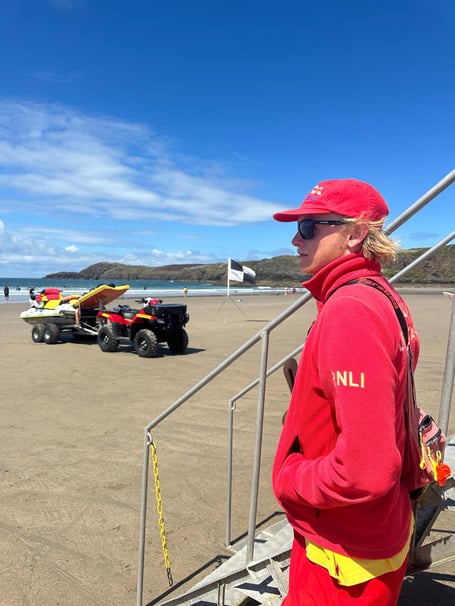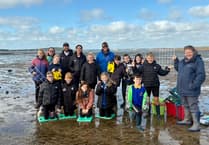In the week that marks World Drowning Prevention Day, Pembrokeshire’s RNLI beach lifeguards have rescued multiple people from rip currents and are strongly encouraging people to visit a lifeguarded beach.
Yesterday, Tuesday, July 23, RNLI lifeguards patrolling at Newgale Beach rescued six people and assisted a further eight people from rip currents.
The combination of 1-2ft surf and the sandbanks at low tide caused an abundance of rip currents to form. RNLI lifeguards were kept busy providing preventative advise to the public and encouraging them to swim between the red and yellow flags.
Senior Lifeguard George Morgan said:
“In total we rescued six people and assisted a further eight, but also gave out preventative advice to hundreds of people.
“The combination of surf, wind, and tide moving across the sandbanks at Newgale often creates flash rip currents. The location of these currents can change every day and are impossible to predict. This forces us to regularly move the flags and dynamically assess the beach.
“We strongly advise that you swim and bodyboard between the red and yellow flags or surf, kayak and paddleboard between the black and white flags. The flagged areas are patrolled at all times by our lifeguards between 10am-6pm.
“If you see the red flag flying, we have deemed that area of the beach as unsafe, most commonly due to rip currents.”
Not long after midday, at the north end of Newgale Beach, a flash rip current appeared. Two bodyboarders were rescued and three surfers were assisted out of the rip current by Lifeguard Jake Rogers.
Shortly after, another two bodyboarders were stuck in a rip current and struggling to return to shore. Once again, Jake Rogers made his way to them on a rescue board and assisted them back to shore.
The Rescue Water Craft (RWC) was launched to guide people to stay within the correct flagged areas. Lifeguard George Morgan was operating the RWC and spotted two bodyboarders floating out to sea. He immediately made his way towards them as they realised they were in trouble and were waving for assistance.
George assisted one of the casualties onto the RWC sled and Lifeguard Travis Christopher-Mullins had made his way out on a rescue board and helped the second casualty onto his board. Both casualties were returned safely to shore.
Shortly after, Lifeguard Jake was patrolling on the RWC and came across a surfer in a rip current. He assisted the surfer and ensured he could safely return to the beach. Once back on patrol, Jake spotted another two swimmers who were struggling in a rip current. He helped them onto the rescue sled and returned them to shore.
Just before the end of the lifeguards’ shift, Lifeguard Cai Owen spotted two bodyboarders who were a long way out of their depth. The bodyboarders were in a rip current, so Cai made his way out to them on a rescue board and assisted them back to shore.
Stuart Penfold, Lead Lifeguard Supervisor for North Pembrokeshire said:
“If you find yourself caught in a rip current, don’t swim against it or you’ll get exhausted. If you can stand, then wade don’t swim. If you can, try to swim parallel to the shore until you’re free of the current, and then head back to shore. Always raise your hand and shout for help.
“If you’re ever unsure as to why we’ve red flagged the beach, please approach our lifeguards. We’re more than happy to offer guidance and direct you to a safer place to swim.
“In Pembrokeshire the following beaches are currently being patrolled every day from 10am-6pm: Newport Sands, Poppit Sands, Whitesands, Newgale Central and South, Broad Haven, Freshwater West, Tenby North, Tenby Castle, Tenby South and Saundersfoot.
“Choose one of our lifeguarded beaches if you’re planning a dip.”
To find your nearest lifeguarded beach visit: Lifeguarded Beaches - Find Your Nearest Lifeguarded Beach (rnli.org)





Comments
This article has no comments yet. Be the first to leave a comment.